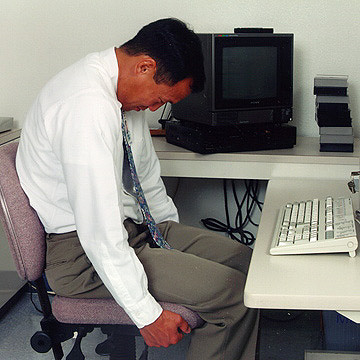If you've found this website helpful, please click the Donate button. Thanks for the support.
Fitness Articles
Like the site? Sign up for the FREE newsletter. I'll send a new article once or twice a month. Unsubscribe
anytime.
anytime.

About this Site l Contact l Free Newsletter l Subscribe to RSS Feed
Recommended Products l Fitness Store l Directly Fitness Blog
Recommended Products l Fitness Store l Directly Fitness Blog
Continue to learn more about stretching: Fitness Articles Home
By:Alex Borja
Odds are that if you are reading this that you know the importance that stretching can have on your training goals and everyday life. Ideally everyone should be stretching daily but sometimes this may be somewhat different or impractical to do.
On the job stretching:
I would recommend that for every hour of sitting on the job that at least 5 minutes of movement be mandatory. You can either stretch or take a walk around the building or block but get moving in an upright position! Sitting for prolonged periods leads to tight muscles such as hip and neck flexors. 5 minutes is an absolute minimum and really should be 10-15 minutes but take as much time as your job allows.
There are simple and easy stretches you can even do in your workspace and many from the very chair you’re sitting in! I found an awesome guide to simple yet very effective stretches that can be done right at your desk. You can find them here.
For those of you who may feel a bit weird about
stretching at work there are other ways around this
but may not be as effective. But as always,
something is most definitely better than nothing.
Stretching for 10 minutes in the morning before
work and 10 minutes after work should help with
tight muscles. If you feel even this is too much for
your busy schedule start even smaller but work your
way up. I promise you as it becomes part of your
daily routine you WON’T want to start your day
without stretching. It will begin to feel pleasant
and the rest of your day your body will feel good and
relaxed.
Tips for stretching:
• Don’t stretch too hard! On a scale of 1-10 with 1 feeling barely any pain or discomfort and 10 being excruciatingly painful, you want a stretch of about 6-7. Nobody said stretching was the greatest feeling in the world especially when you first start but you also don’t want to make it hurt. It should feel "slightly uncomfortable"—so strive for actually feeling the stretch without pain. As you continue to stretch your body will adapt and the stretching sensation wont seem as foreign to you. It will become a more natural experience with many benefits.
• Be sure to hold each stretch for at least 15-30 seconds. You may feel a more intense pull and 10-15 seconds later a “give” sensation as your muscle relaxes. I won’t bore you with the science behind this phenomenon but just know that you should strive to hold your muscle at least 10 seconds after you feel that relaxing muscle sensation. For some this will be after 10 seconds and others may have to hold tight muscles for 30 seconds or more before the relaxation occurs.
• Don’t bounce when doing these stretches. It can lead to pulling or straining your tight muscles and lead to even more tightness and pain. Slowly stretch and don’t jerk or bounce. Forcing your muscles to stretch farther than what feels natural can lead to injury and should be avoided. You want to adapt your body to stretching—not force it.
• If you ever feel pain, remember to just don’t do it! There are several variations of stretches that can be replaced if a given stretch does not feel “right”. You will know if your muscles being stretched don’t feel like a normal muscle stretch. You might feel a sharp sensation which could indicate you’re giving yourself a nerve stretch—not very pleasant. Anything out of the "slight discomfort" zone should not be performed.
• I recommend from personal experience to go through “cycles” of stretches. Pick about 8-10 stretches depending on what part of my body feels the tightest, hold one side (ex. Right leg) stretch on each side about 15-25 seconds and then switch to the other for 15-25 seconds (ex. Left leg) and repeat 3-5 times. So basically if you are feeling tight in a muscle group or anticipating being in a certain position for a while focus on those muscles and perform these mini cycles to thoroughly stretch the muscles.
• To elaborate on the above tip, know what muscles you are going to be using throughout the day and stretch before during and after. This can save you a world of tightness and pain if you anticipate for the future.
For instance, if you know you will be sitting all day than you can anticipate certain muscle groups that will be tight by the end of the day. If you are a desk worker you have undoubtedly felt which muscles are overworked sitting at a desk all day. Muscles such as the hamstrings, erector spinae and multifidus (lower back), neck, and shoulders are all affected. Anticipation is the key.
Subscribe
Stretching at Work Made Easy
Subscribe it.
Donate it.
Share it.

Chair stretches such as this one can easily be done from the comfort of ones own workspace


